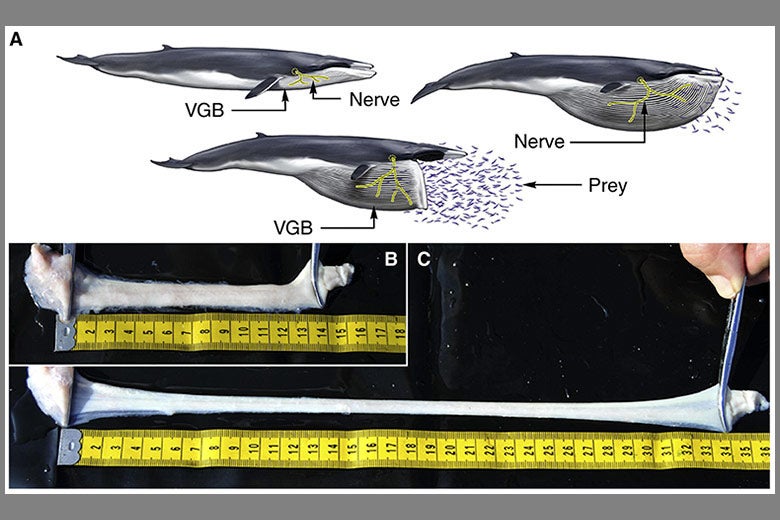
Stanford biologists have discovered how fin whales can inflate their mouths by 150 percent: unique extensible nerves which can stretch to more than double their length without damage. (Image credit: Illustration: C. Buell; photo: Vogl et al.)
It is no surprise that an animal the size of three school buses takes very big bites. Hundreds of times a day, a fin whale gulps in a swimming pool’s worth of water to fill its belly with krill – a hallmark of many gigantic filter feeders in the ocean.
What has come as a surprise to scientists is the discovery of the unique underlying physiology that allows this manner of feeding: nerves that stretch like bungee cords. The discovery, made by biologists at Stanford and other universities, reveals a nerve construction unlike any other in the animal kingdom, and could help scientists understand nerve damage in humans.
In most instances in the animal kingdom, stretching a nerve leads to undesirable consequences. “Nerve stretch injury,” the most common type of nerve trauma in humans, can result in pain, paralysis, muscle atrophy and loss of sensation. Mild injuries in mammals typically occur when the nerve stretches beyond 6 percent, with total mechanical failure occurring at stretch points of around 29 percent.
For rorqual whales – a group that includes fin, blue, minke and humpback whales – stretchable nerves are a matter of necessity. These whales intermittently engulf and filter immense volumes of krill-filled water through a technique called “lunge filter feeding.”
Upon spotting a patch of krill or school of fish, the whale accelerates and opens its jaw until it is nearly at a 90-degree angle from its body. As water rushes in, the floor of the whale’s mouth, which is composed of muscle and blubber, expands like a water balloon. The cavity grows in circumference by roughly 150 percent, and the total volume of intake can exceed that of the whale itself. The whale pushes the water back out through its mouth, catching food in the brush-like baleen plates near the front of the mouth.
During dissection, the researchers discovered that the blubber and tongue nerves could stretch, on average, 75 percent to 115 percent before failing. They extend quickly, but stiffen abruptly, owing to their unique construction.
“It was truly fascinating to grab on to one of these nerves and to reversibly stretch the tissue and double its resting length,” said study co-author Jeremy Goldbogen, an assistant professor of biology at Stanford’s Hopkins Marine Station.
The nerve fibers are concentrated in the core of the nerve, arranged in simple folds, and wrapped in a layer of very thick elastin and collagen. The researchers suggest that when the whale begins its lunge, the fibers unfold and stretch quickly, with the collagen sleeve eventually functioning as a “check ligament” to prevent overstretching. As the oral cavity returns to its pre-lunge size, the elastin acts to recoil the nerve into a folded bundle.
Without such highly extensible nerves, the whales could not perform lunge feeding as efficiently, the scientists write. As such, extensible nerves should be considered one of the key morphological adaptations that allowed rorqual whales to become the largest animals on the planet.
This discovery adds to other recent studies that have uncovered unique anatomical adaptations in whales that are not observed in any other animal, including a novel sensory organ in the whale’s chin and unique bungee cord-like muscles within the feeding pouch that extend much like the nerves in this study.
“This emphasizes the importance of comparative organismal physiology in that we can discover unique adaptations that may inspire next-generation applications in bioengineering, medicine and beyond,” Goldbogen said.
The study is published in the current issue of Current Biology. Co-authors of the study include A. Wayne Vogl, Margo A. Lillie, Marina A. Piscitelli and Robert E. Shadwick, of the University of British Columbia, and Nicholas D. Pyenson of the National Museum of Natural History.
Media Contacts
Bjorn Carey, Stanford News Service: (650) 725-1944, bccarey@stanford.edu
Jeremy Goldbogen, Stanford Biology: jergold@stanford.edu